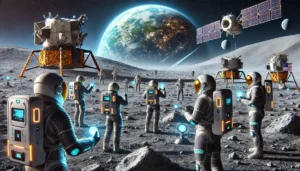
Have you ever glanced at the night sky, closed one eye, and tried to imagine standing on that luminous orb we call the Moon? Lately, whispers about space tourism—especially commercial flights to the Moon—have turned that stargazing fantasy into a plausible reality. But how realistic is it, anyway, to think you could strap yourself into a rocket and zip off to spend a few nights on our celestial neighbor? Let’s wander through the complexities of political chatter, government plans, the perspectives of older folks who once believed the Moon was a mere dream, and the tech-savvy youth who are raring to take zero-gravity selfies on lunar soil. The path might be bumpy, with unexpected detours—imagine random asteroids—but it’s guaranteed to be one heck of a cosmic ride.
The Gleam of Lunar Possibility
Ever since the first footprints were etched onto the Moon’s dusty surface in 1969, the idea of everyday citizens making that same trek has danced on the edges of our collective imagination. Yet, if you’d asked your grandparents, they’d probably give you an incredulous eye-roll: “That’s too far-fetched!” At the same time, younger generations might casually shrug and say, “Cool, so when do we board?”
From a formal vantage point, NASA, as highlighted in its Houston We Have a Podcast episode on space tourism, has shifted some focus toward commercial partnerships. Private entities like SpaceX, Blue Origin, and Boeing have leaped into the fray, building rocket prototypes capable of ferrying not just astronauts but also well-heeled tourists to orbits around Earth—and, soon, around the Moon. Meanwhile, the Congressional Research Service report (R46500) notes that the U.S. government actively supports policies to commercialize low Earth orbit. That’s a fancy way of saying Uncle Sam thinks space tourism is a new frontier worth exploring—and possibly taxing.
But are we even near the cusp of building a bustling lunar tourism industry? Or is it all smoke and mirrors? A few slip-ups might happen here—like whether 2023, 2024, or 2025 is the actual pivotal year for human flight expansions beyond Earth’s orbit. Some experts from ResearchGate’s publication on Space Tourism believe ongoing technological improvements will slash costs over the next decade, but it’s still up in the air—literally.
Global Business & Government Involvement
Politics, for better or worse, can either turbocharge or torpedo space tourism. In certain parliamentary sessions in Europe, eyebrows have been raised about funneling taxpayer money into lunar lodging concepts. In the United States, NASA’s Artemis program is forging alliances with private companies. For instance, the CRS report R46500 details the collaborations that could shape future Moon expeditions. In a way, NASA is keen to share the load (and the cost) with commercial enterprises.
Governments from rising spacefaring nations—like China’s National Space Administration—have shown an equal measure of curiosity. There have been rumors that multi-nation partnerships might one day build a lunar base. Then again, we’ve also heard that some political factions prefer to keep space exploration strictly for scientific missions instead of “joy rides” for the uber-rich. Contradiction thrives here. One side hails the potential surge of high-tech jobs and the impressive revenues from wealthy travelers seeking a once-in-a-lifetime experience; another side worries about militarizing space or ignoring pressing social issues on Earth while we chase cosmic fantasies.
At times, it’s a clown-car environment: everyone is piling in with different agendas. But that’s also the spark that keeps the conversation going. With all this swirling interest, research labs like the Jet Propulsion Laboratory (JPL) and private outfits such as SpaceX’s Boca Chica facility are rummaging through advanced propulsion methods, investigating radiation shielding for passenger safety, and even dabbling in artificial gravity. Meanwhile, slightly less-known laboratories, from Asia to Europe, keep popping up with new designs for spacecraft materials meant to endure deep-space journeys.
Celebrity Endorsements and Starry-Eyed Enthusiasm
Do you remember the first time a major celebrity tweeted about going to the stratosphere? It turned heads everywhere. The rumor mill has churned with reports that certain well-known pop stars—who cameo in blockbuster films—are on waiting lists for suborbital or orbital flights. Folks from The Business Standard’s coverage on space tourism have speculated that these VIP voyages will give the sector a major PR boost. After all, if a beloved icon is floating in zero gravity with an awe-struck grin, can the rest of us resist wanting a piece of that cosmic enchantment?
Elon Musk tweeted at one point (or maybe it was retweeted by a fan account, it gets confusing) that these voyages mark a new age of exploration. Celebrities, in turn, might post selfies in launch suits, fueling public curiosity. Sometimes you can almost hear your coworker say, “Oh, if that big Hollywood name can handle a rocket ride, maybe I can, too.” Meanwhile, critics might sneer: “Sure, if you have tens of millions of dollars to spare.” That tension will likely remain until costs plummet.
Older Generation Reflections and Social Dimensions
I remember asking my grandmother if she’d visit the Moon someday. She smirked with that half-disbelieving grin. For her, the memory of the Apollo 11 mission in 1969 still feels surreal, and she remains skeptical about “commercial flights for regular people.” She points to the hazards of cosmic radiation and the comedic possibility of a tourism meltdown on the lunar surface if something goes awry.
And yet, some older individuals are profoundly intrigued. They see it like a bucket-list item, akin to skydiving or traveling around the world. “Before I die,” I heard one senior citizen declare at a community center, “I’d sure love to peek out a spaceship window and see Earth looking like a giant marble.” Socially, the conversation often dances between amazement and caution, especially among those who still recall the heartbreak of space shuttle tragedies.
There’s also the subtle socio-economic question: Will space tourism widen the gap between the super-rich and everyday folks? Some seniors bristle at the idea that only billionaires will get to break Earth’s gravity. They’d like to see scholarships or lottery-based seats so that people from all walks of life can taste that cosmic wonder. Indeed, that conversation about inclusivity is booming across social media. Sure, it might be complicated, but it’s stoking the debate about how accessible these future flights ought to be.
The Youthful Dreamers—and Their Apps
Young people, on the other hand, talk about going to the Moon as if it’s the next big holiday destination—almost like planning a gap year in a faraway country. They follow rocket launches on streaming platforms and gobble up every snippet about NASA’s Artemis missions. Some even develop crowdfunding pages with titles like “Help Me Book My Lunar Ticket.” A bit naive, you might think, but that’s part of the charm.
As gleaned from Space Tourism: An Initiative Pushing Limits, the younger generation’s tech-savviness fuels an avalanche of creative ideas. College students participate in robotics competitions aimed at designing lunar rovers. High-school clubs raise funds for microgravity experiments. Even the entrepreneurial-minded look to create apps that track cosmic flight schedules, or VR experiences that simulate walking in low gravity. They imagine entire influencer campaigns from the Moon. Perhaps in 2025 (or 2030—nobody’s pinned an exact date), you might see a wave of social media posts featuring #MoonLandingAgain.
Yet within this youthful excitement lurks the question: Are they aware of the personal risks and astronomical expenses? In a few high school chat rooms, I’ve seen some kids discussing the radiation hazard or the possibility of cosmic dust infiltration. The conversation can pivot from sparkly excitement to serious reflection in a blink. Indeed, some teens are more grounded than we give them credit for.
Research Labs and Scientists—Forever Chasing Answers
To legitimize space tourism, scientists remain front and center. Labs funded by major agencies or private donors scramble to address the complexities of sustained living outside Earth’s protective shield. Consider ScienceDirect’s study on advanced space habitats, which explores 3D-printed habitats using lunar regolith. Meanwhile, findings from Emerald Insight’s publication on the future of tourism highlight the psychological impact of traveling in zero gravity—things like claustrophobia, motion sickness, or plain old fear. Because let’s face it, it’s not like you can roll down the window for fresh air mid-flight.
These labs also collaborate with government and private players to refine rocket engines, perfect life support systems, and reduce launch costs. In some ways, the synergy between commercial entities and research institutions is reminiscent of the early days of the aviation boom. If we can reduce rocket reusability costs, so the argument goes, tickets will eventually fall from tens of millions of dollars to maybe just a few hundred thousand—and eventually, we hope, down to the price of a luxury cruise. But that might be an optimistic timeline. Still, progress is notable: Reusable rocket boosters have already cut some recurring expenses, and new test flights pop up almost weekly.
Contemplating the Cost and Commercial Viability
One of the biggest stumbling blocks is, of course, money. We’ve heard rumors—some from fairly credible sources, others from random corners of social media—that a single Moon orbit ticket might run around $50 million or more. Is that feasible for the average person? Not really. Yet, businesses remain bullish. The Iberdrola analysis on space tourism mentioned the possibility of exponential growth once technology matures and competition intensifies.
The commercial potential is enormous: hotels with lunar views, guided tours to explore the remains of old Moon landers, or even golf tournaments in one-sixth gravity. We might see entire mega-corporations spring up around rocket tourism. If you think about the tourism supply chain—rocket engineering, spaceport services, specialized spacesuits, in-flight entertainment—there’s a goldmine in each link. A recent piece on AstforGeTech’s website also underlines how early adopters (the wealthy thrill-seekers) will fund the industry’s infancy, paving the way for more affordable mass travel.
From the vantage point of big business, global revenues could skyrocket (pun intended). Some financiers imagine the sector eventually eclipsing even the commercial aviation market. Others remain more conservative, believing that high costs and strict safety regulations will limit the scale. Government notes from CRS reports highlight how liability and legal frameworks remain uncertain—who’s responsible if a tourist trip ends in disaster?
Political Debates and Government Notes
It’s fascinating—and sometimes comical—to see how political figures from different countries respond. One day, a senator passionately argues we should focus on Earthly issues like climate change or healthcare. The next day, another politician counters that exploring the cosmos fosters new technology that can have real-world benefits, from improved communication satellites to advanced robotics. So, from a governance perspective, there’s a balancing act.
For instance, NASA’s budget allocations for partnering with private companies must pass congressional approval. If there’s an economic downturn, these budgets might shrink, stalling projects. Meanwhile, in the European Union, politicians weigh the environmental impact of frequent rocket launches. Even local governments in states like Texas or Florida fight for hosting launch sites because they can bring jobs and tourism to the region. The CRS document R46500 briefly touches on the role of states as stakeholders, highlighting the tricky patchwork of regulations that need alignment before space tourism can truly flourish.
Tying that to a more personal dimension, it’s possible that some corners of the public remain unaware of the political dance behind each rocket that blasts off. If you’ve ever tried to read about the licensing requirements from the Federal Aviation Administration’s Office of Commercial Space Transportation—yes, that’s a mouthful—it can make your head spin. Multiply that across multiple nations with their own agencies, and you’ve got a puzzle with a thousand pieces, many of them missing at the moment.
Societal Impact—Awkward Yet Exhilarating
If flights to the Moon become commonplace, even if “commonplace” means a few hundred people a year, it’ll alter how we perceive our planet, maybe even how we define ourselves. Religious groups might hold spiritual significance for standing on the surface of another celestial body. Environmental advocates might caution about the carbon footprint associated with frequent launches, though some argue new propulsion methods could minimize that effect.
From a cultural standpoint, imagine the art and music that could emerge from actual lunar experiences. Think about new wedding trends—couples exchanging vows in orbit, overshadowed by the Earth’s glow. Admittedly, that might sound bizarre, but it’s not entirely impossible. We’re heading toward a future in which glimpses of Earth from space aren’t limited to a handful of NASA astronauts or cosmonauts. It might become an option for retirees splurging on an ultimate final adventure or for newlyweds seeking an epic honeymoon.
Yet there’s also the intangible sense that once you’ve seen Earth from the Moon, you’ll never again see life in the same way. Many astronauts recount a profound shift in perspective that fosters unity and peace, a phenomenon sometimes referred to as the “Overview Effect.” Could mass exposure to that vantage point revolutionize our social attitudes? Or, ironically, would it become trivial over time, just another box on the bucket list? The deeper you go into these questions, the more cosmic mysteries you unearth.
An Imperfect Trajectory Toward 2025 and Beyond
We’re not living in an immaculate storyline. One day, a rocket might fail a test flight, sowing fear among potential passengers and spurring a flurry of lawsuits. Another day, a government might abruptly freeze funding, delaying everything. Then again, maybe we’ll see breakthroughs in propulsion or radiation shields that expedite the timeline. The dream of sipping space coffee while gazing at Earth’s swirling clouds from a Moon base could be realized sooner than we anticipate.
Key players like SpaceX, Blue Origin, and other new entrants keep forging deals with research labs. The synergy is weirdly mesmerizing: business leaders rubbing shoulders with scientists, older folks marveling at a changing reality, and youth impatiently awaiting the moment they can tweet “My flight to the Moon boards in T-10 minutes, see you in orbit!” If we do get it right, space tourism to the Moon could be the next giant leap for humankind. If we stumble—well, that might just be part of the cosmic drama.
Sure, we might face logistical nightmares, economic pitfalls, or political deadlocks. Those are the background hum of any major revolution. Right now, it feels like we’re strapped into a rocket, about to pass the final countdown. The future of commercial lunar flights stands at the intersection of technology, policy, cultural dreams, and even the human spirit. We can’t know for certain how soon or how smoothly it’ll happen. But the notion that it can happen at all is enough to leave many of us starry-eyed.

FAQs
Q1: Is space tourism safe enough for ordinary people?
Safety remains a work in progress. Current flights cater mostly to trained astronauts or extremely wealthy individuals who undergo brief orientations. As research labs refine technology and develop better radiation shields, safety will improve—though it might be a few years before “ordinary” folks feel entirely comfortable heading moonward.
Q2: How much does a lunar vacation cost?
Estimates vary. Some private companies have hinted at price tags upward of $50 million for a single seat, but with increased competition and advancements in rocket reusability, these expenses are projected to decrease. Eventually, the hope is that traveling to the Moon could cost a fraction of that, but we’re not there yet.
Q3: What do governments say about moon tourism?
The stance varies by country. In the U.S., NASA’s Artemis program collaborates with private firms. The CRS (R46500) emphasizes creating legislation around commercial space travel. In Europe, there’s debate on whether such projects merit public funding. Countries like China also have lunar exploration goals, though they might prioritize scientific missions over tourism—at least for now.
Q4: Are there any ethical or environmental concerns?
Yes, rocket launches contribute to carbon emissions and can affect local communities near spaceports. Environmental groups question the sustainability of frequent launches. Ethical debates center on whether resources should address Earth’s immediate needs or push humanity’s presence into space. However, many experts note that space exploration has historically led to technologies that benefit Earth, so it’s not simply a drain.

External Links
- External Links (high-authority references):





